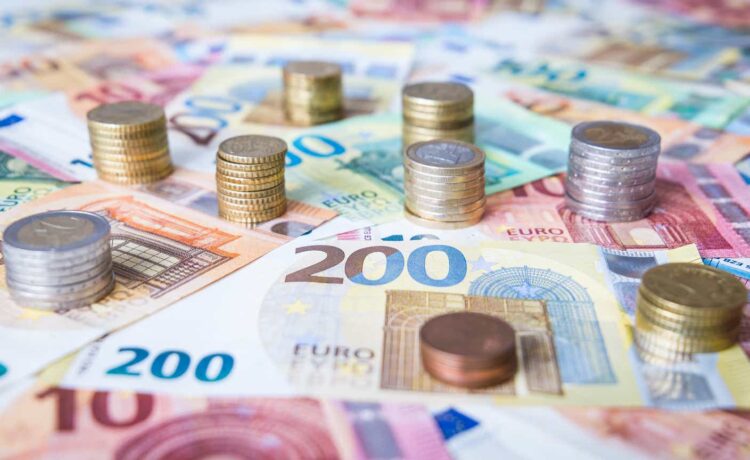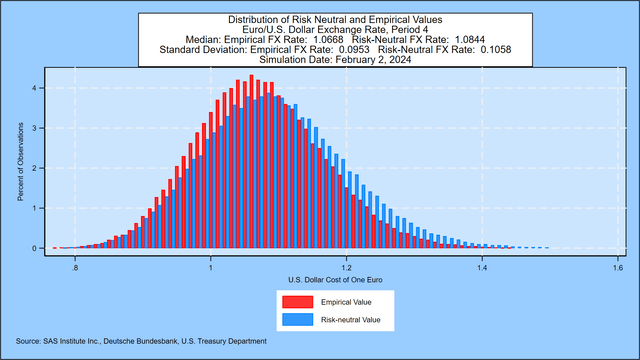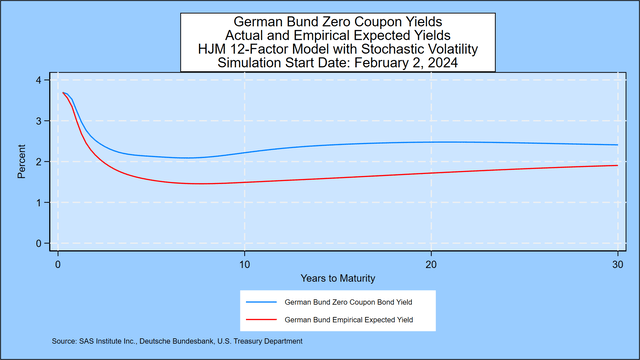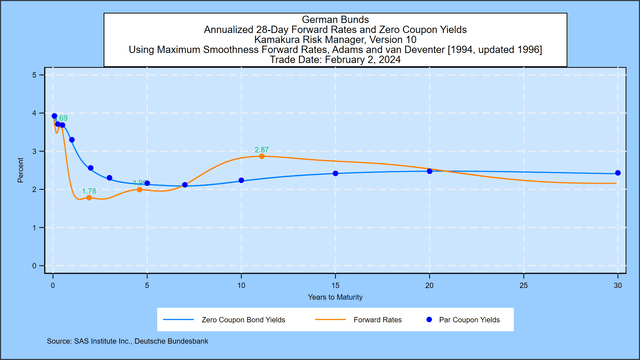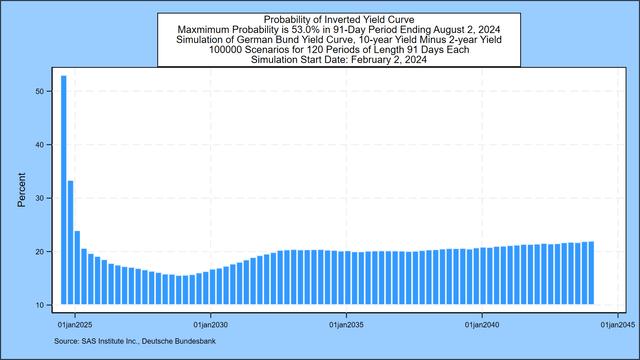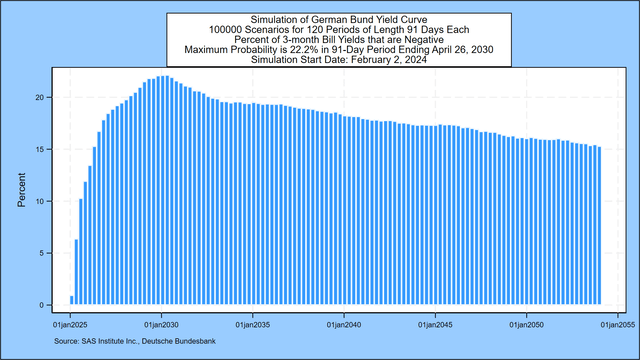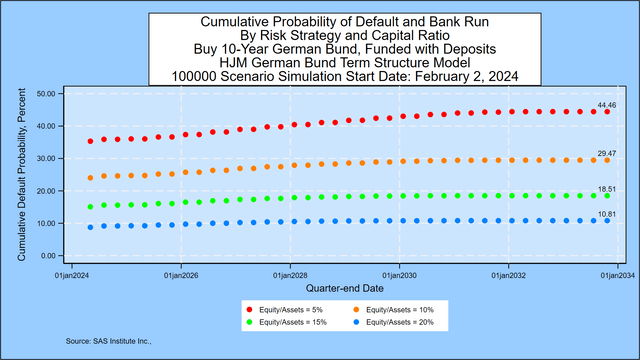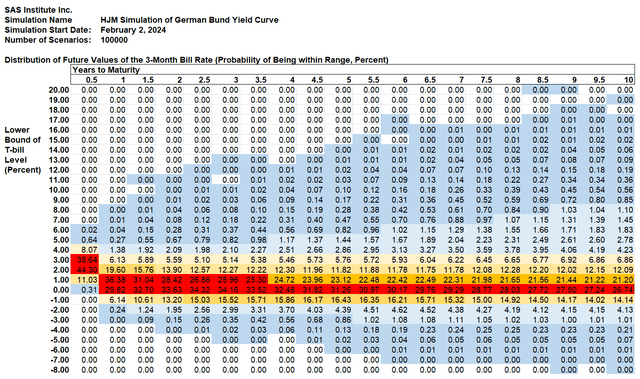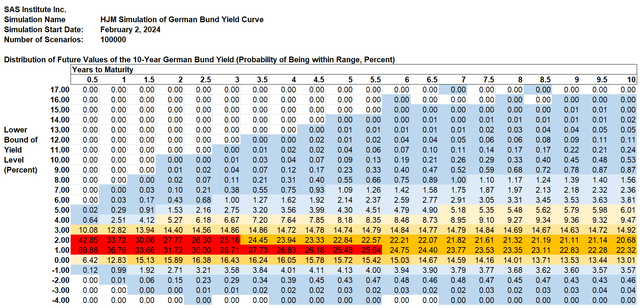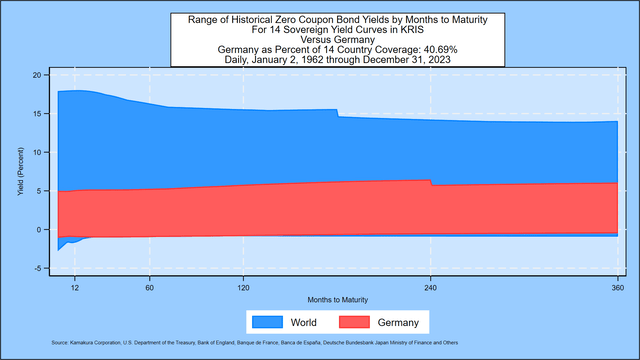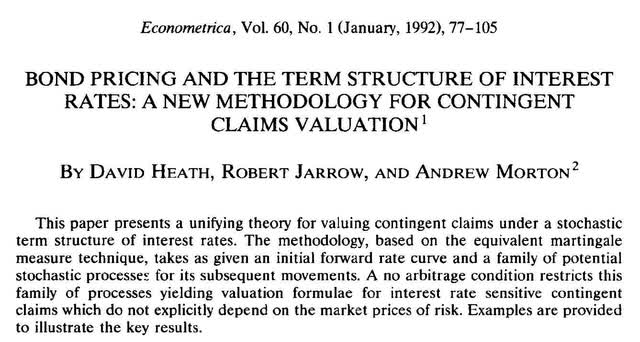Photofex
Author’s Note
This simulation has been done jointly with a U.S. Treasury yield simulation in a way that reflects the correlation among the 12 factors driving yields in each country. For more on the companion U.S. Treasury simulation, please contact the author. Both the Bund and the U.S. Treasury yield simulations impact foreign exchange rates, resulting in the following distribution of the Euro/U.S. dollar exchange rate one year forward:
This Week’s Simulation of Bund Yields
As explained in Prof. Robert Jarrow’s book cited below, forward rates contain a risk premium above and beyond the market’s expectations for the 3-month forward rate. We document the size of that risk premium in the graph below, which shows the zero-coupon yield curve implied by current German Bund prices compared with the annualized compounded yield on 3-month bills that market participants would expect based on the daily movement of government bond yields in 14 countries since 1962. The risk premium, the reward for a long-term investment, is moderately positive and remains so over the full maturity range to 30 years. The graph also shows a steady downward shift in yields in the first seven years, as explained below.
For more on this topic, see the analysis of government bond yields in 14 countries through December 31, 2023 given in the appendix.
Inverted Yields, Negative Rates, and German Bund Probabilities 10 Years Forward
In this week’s Euro zone forecast, the focus is on three elements of interest rate behavior: the future probability of the recession-predicting inverted yield curve, the probability of negative rates, and the probability distribution of German Bund yields over the next decade.
We start from the closing German Bund yield curve published daily by the Deutsche Bundesbank and other information sources. Using a maximum smoothness forward rate approach, Friday’s implied forward rate curve shows a quick rise in 1-month rates to an initial peak of 3.69%, compared to 3.87% last week. After the initial rise, there is some volatility until rates peak again at 2.87%, a change from 3.11% last week, and then decline to a lower plateau at the end of the 30-year horizon.
Using the methodology outlined in the appendix, we simulate 100,000 future paths for the German Bund yield curve out to thirty years. The next three sections summarize our conclusions from that simulation.
Inverted Bund Yields: Inverted Now, 53.0% Probability by August 2, 2024
A large number of economists have concluded that a downward sloping yield curve is an important indicator of future recessions. A recent example is this paper by Alex Domash and Lawrence H. Summers.
We measure the probability that the 10-year par coupon Bund yield is lower than the 2- year par coupon Bund for every scenario in each of the first 80 quarterly periods in the simulation.[1] The next graph shows that the probability of an inverted yield peaks at 53.0% in the 91-day quarterly period ending July 26, 2024 compared to 58.1% last week.
Negative 3-Month Yields: 22.2% Probability by April 26, 2030
The next graph describes the probability of negative 3-month bill rates for all but the first 3 months of the next 3 decades. The probability of negative rates starts near zero but peaks at 22.2%, compared to 25.9% last week, in the period ending April 26, 2030.
Calculating the Default Risk from Interest Rate Maturity Mismatches
In light of the interest-rate-risk-driven failure of Silicon Valley Bank in the United States on March 10, 2023, we have added a table that applies equally well to banks, institutional investor, and individual investor mismatches from buying long-term German Bunds with borrowed short-term funds. We assume that the sole asset is a 10-year German Bund purchased at time zero at par value of 100 euros. We analyze default risk for four different initial market value of equity to market value of asset ratios: 5%, 10%, 15%, and 20%. For the banking example, we assume that the only class of liabilities is deposits that can be withdrawn at par at any time. In the institutional and retail investor case, we assume that the liability is essentially a borrowing on margin/repurchase agreement with the possibility of margin calls. For all investors, the amount of liabilities (95, 90, 85 or 80) represents a “strike price” on a put option held by the liability holders. Failure occurs via a margin call, bank run, or regulatory take-over (in the banking case) when the value of assets falls below the value of liabilities.
The chart below shows the cumulative 10-year probabilities of failure for each of the 4 possible capital ratios when the asset’s maturity is 10 years. For the 5 percent case, that default probability is 44.46%, a change from 44.15% last week.
This default probability analysis is updated weekly based on the German Bund yield simulation described in the next section. The calculation process is the same for any portfolio of assets with credit risk included.
German Bund Yield Probabilities 10 Years Forward
In this section, the focus turns to the decade ahead. This week’s simulation shows that the most likely range for the 3-month bill yield in the Bund market in ten years is from 0% to 1%, unchanged from last week. There is a 26.74% probability that the 3-month yield falls in this range, a change from 27.13% one week before. Note the shift downward in the second and third semi-annual periods. For the 10-year Bund yield, the most likely range is from 1% to 2%, also unchanged from last week. The probability of being in this range is 22.32%, compared to 22.16% one week prior.
In a recent post on SeekingAlpha, we pointed out that a forecast of “heads” or “tails” in a coin flip leaves out critical information. What a sophisticated bettor needs to know is that, on average for a fair coin, the probability of heads is 50%. A forecast that the next coin flip will be “heads” is literally worth nothing to investors because the outcome is purely random.
The same is true for interest rates.
In this section we present the detailed probability distribution for both the 3-month bill rate and the 10-year Bund yield 10 years forward using semi-annual time steps[2]. We present the probability of where rates will be at each time step in 1 percent “rate buckets.” The forecast for 3-month bill yields is shown in this graph:
3-Month Bill Yield Data:
The probability that the 3-month bill yield will be between 1% and 2% in 2 years is shown in column 4: 28.42%. The probability that the 3-month yield will be negative (as it has been often in Europe and Japan) in 2 years is 13.20% plus 1.95% plus 0.15% plus 0.00% = 15.29% (difference due to rounding). Cells shaded in blue represent positive probabilities of occurring, but the probability has been rounded to the nearest 0.01%. The shading scheme works like this:
- Dark blue: the probability is greater than 0% but less than 1%
- Light blue: the probability is greater than or equal to 1% and less than 5%
- Light yellow: the probability is greater than or equal to 5% and 10%
- Medium yellow: the probability is greater than or equal to 10% and less than 20%
- Orange: the probability is greater than or equal to 20% and less than 25%
- Red: the probability is greater than 25%
The chart below shows the same probabilities for the 10-year Bund yield derived as part of the same simulation.
10-Year German Bund Yield Data:
Appendix: Bund Yield Simulation Methodology
The probabilities are derived using the same methodology that SAS Institute Inc. recommends to its KRIS® and Kamakura Risk Manager® clients. A moderately technical explanation is given later in the appendix, but we summarize it briefly first.
Step 1: We take the closing Bund yield curve as our starting point.
Step 2: We use the number of points on the yield curve that best explains historical yield curve shifts. We note in the following graph that Bund yields span (by rate level and maturity) only 40.69% of the historical experience in 14 countries:
For the highest degree of realism in a forward-looking simulation, using the international database is essential. Using daily government bond yield data from 14 countries from 1962 through December 31, 2023, we conclude that 12 “factors” drive almost all movements of government bond yields. The countries on which the analysis is based are Australia, Canada, France, Germany, Italy, Japan, New Zealand. Russia, Singapore, Spain, Sweden, Thailand, the United Kingdom, and the United States of America. No data from Russia is included after January 2022.
Step 3: We measure the volatility of changes in those factors and how volatility has changed over the same period.
Step 4: Using those measured volatilities, we generate 100,000 random shocks at each time step and derive the resulting yield curve.
Step 5: We “validate” the model to make sure that the simulation EXACTLY prices the starting Bund curve and that it fits history as well as possible. The methodology for doing this is described below.
Step 6: We take all 100,000 simulated yield curves and calculate the probabilities that yields fall in each of the 1% “buckets” displayed in the graph.
Do Nominal Yields Accurately Reflect Expected Future Inflation?
We showed in a recent post on Seeking Alpha that, on average, investors have almost always done better by buying long term bonds than by rolling over short term Treasury bills in the United States. That means that market participants have generally (but not always) been accurate in forecasting future inflation and adding a risk premium to that forecast. This study is being updated using the 14-country data set in coming weeks.
Technical Details
Daily government bond yields from the 14 countries listed above form the base historical data for fitting the number of yield curve factors and their volatility. The Bund historical data is provided by the Deutsche Bundesbank. The use of the international bond data increases the number of observations to more than 105,000 and provides a more complete range of experience with both high rates and negative rates than a Bund data set alone provides.
The modeling process was published in a very important paper by David Heath, Robert Jarrow and Andrew Morton in 1992:
The no-arbitrage foreign exchange rate simulation is based on this well-known paper by Amin and Jarrow:
Journal of International Money and Finance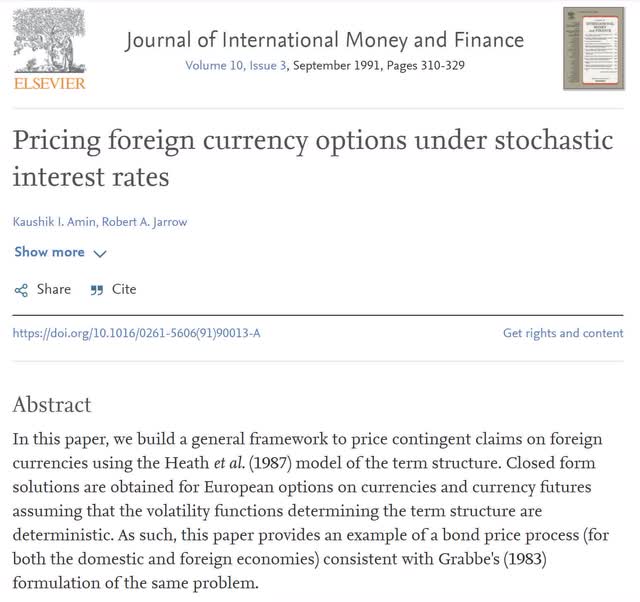
For technically inclined readers, we recommend Prof. Jarrow’s book Modeling Fixed Income Securities and Interest Rate Options for those who want to know exactly how the “HJM” model construction works.
The number of factors, 12 for the 14-country model, has been stable for some time.
Footnotes:
[1] After the first 20 years in the simulation, the 10-year yield cannot be derived from the initial 30-year term structure of yields.
[2] The actual simulation uses 91-day time steps and spans a 30-year time horizon.
Editor’s Note: This article covers one or more microcap stocks. Please be aware of the risks associated with these stocks.

